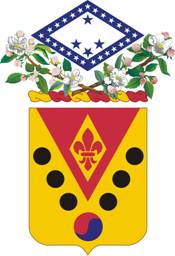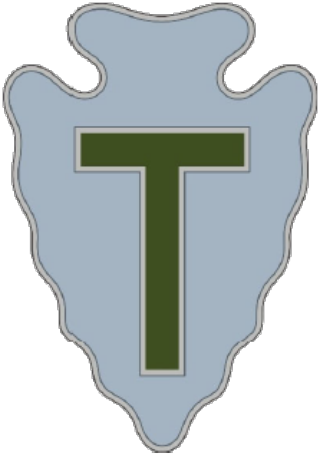
The 36th Infantry Division ("Arrowhead") also known as the "Panther Division", the "Lone Star Division", "The Texas Army", and the "T-patchers", is an infantry division of the U.S. Army and part of the Texas Army National Guard. The 36th Infantry Division was first organized during World War I (1914–1918) from units of the Texas and Oklahoma National Guards. After the war, the division was reformed as an all-Texas unit, and was called to service for World War II (1937–1945) on 25 November 1940, was deployed to the European Theater of Operations in April 1943, and returned to the Texas National Guard in December 1945.

The 39th Infantry Brigade Combat Team, also officially known as The Arkansas Brigade, is an infantry brigade combat team of the Army National Guard composed of personnel from the U.S. states of Arkansas, Missouri, and Nebraska. The unit is the largest Army National Guard command in Arkansas and is headquartered at the Camp Robinson Maneuver Training Center. It was ordered into federal service in 2003 in support of Operation Iraqi Freedom II. The 39th was attached to the 1st Cavalry Division and served in and around Baghdad for a year, returning to the United States in March 2005.

The 35th Infantry Division, formerly known as the 35th Division, is an infantry formation of the United States Army National Guard headquartered at Fort Leavenworth, Kansas.

The 31st Infantry Division ("Dixie") was an infantry division of the United States Army National Guard, active almost continuously from 1917 to 1968. Composed of men from Alabama, Florida, Georgia, Louisiana, Michigan, Illinois, and Mississippi at various points in its existence, the division saw service in both World War I and World War II, and was mobilized during the Korean War, although it was not sent overseas in the latter.

The 33rd Infantry Division was a formation of the U.S. Army National Guard between 1917 and 1968. Originally formed for service during World War I, the division fought along the Western Front during the Battle of Amiens, the Battle of Hamel, the Meuse-Argonne Offensive, at the Second Battle of the Somme, and at the Battle of Saint-Mihiel. It was re-formed during the inter-war period, and then later activated for service during World War II, seeing action against the Imperial Japanese Army in the Pacific. In the post war era, the division was reconstituted as an all-Illinois National Guard division. In the late 1960s, the division was reduced to a brigade-sized formation, and its lineage is currently perpetuated by the 33rd Infantry Brigade Combat Team.

The "Mississippi Rifles" or the 155th Infantry Regiment, is Mississippi's oldest National Guard unit. Its history predates statehood, back to June 1799, and it is the seventh oldest infantry regiment in the United States Army. They patrolled the frontiers of the Mississippi Territory, captured Aaron Burr, defended Fort Mims during the Indian Wars, and served under General Andrew Jackson in the Battle of New Orleans in the War of 1812.

The 142nd Field Artillery Regiment is a United States Army field artillery regiment currently represented in the Arkansas Army National Guard by the 1st Battalion, 142nd Field Artillery, headquartered in Bentonville, Arkansas; 2nd Battalion, 142nd Field Artillery, headquartered in Barling, Arkansas; and Battery F, 142nd Field Artillery stationed in Fayetteville, Arkansas, elements of the 142nd Field Artillery Brigade which is headquartered in Fayetteville, Arkansas. The regiment was created in 1917 from the former 2nd Arkansas Infantry. The 142nd Field Artillery shipped to France during World War I but did not see combat before the cessation of hostilities. The regiment was activated for World War II, but its battalions were redesignated as separate battalions, 1–142nd became the 936th Field Artillery Battalion, the 2–142nd became the 937th Field Artillery Battalion. The battalion's served throughout the European Theater of Operations. The battalions were activated again for the Korean War and served throughout the war. Following the Korean War, the separate battalions resumed their former designations of 1–142nd FA and 2–142nd FA. The 142nd Field Artillery Brigade, including both battalions, was activated for Operation Desert Storm. Elements of the 142nd Fires Brigade have been activated for service in Operation Noble Eagle and Operation Iraqi Freedom. The 142nd Fires Brigade was instrumental in support and recovery operations located in New Orleans, Louisiana after hurricanes Katrina and Rita devastated the Gulf Coast.

The 39th Infantry Division was an infantry formation of the Army National Guard, originally formed as the 18th Division in 1917. The division consisted of troops from Arkansas, Louisiana, and Mississippi. After training at Camp Beauregard, Louisiana, the division was deployed to France but did not see combat before the end of World War I. In July 1923 the division was re-designated as the 31st Infantry Division. The 39th Infantry Division was reactivated after World War II with troops from Louisiana and Arkansas and its headquarters in Louisiana. In 1967, the 39th Infantry Division was reorganized to become the 39th Infantry Brigade (Separate). Its headquarters was in Little Rock and the unit consisted entirely of troops from Arkansas.

The 156th Infantry Regiment is an infantry regiment in the United States Army and the Louisiana National Guard. It began as a Confederate Army unit in 1861, and surrendered to the Union at the Battle of Appomattox Court House in 1865. It was reformed in 1878 as a militia unit, and reorganized into the Louisiana National Guard in 1899. It saw support service in World War I. In world War II it served as a guard battalion in Europe, for which it added a lion to its coat of arms to symbolize its service in northern France. It deployed twice during the Iraq war.

The 206th Field Artillery Regiment is a United States artillery regiment, currently represented in the Arkansas Army National Guard by the 1st Battalion, 206th Field Artillery, Headquartered at Russellville, Arkansas. The 1–206th FA is an element of the 39th Infantry Brigade Combat Team.

The 153d Infantry Regiment is a United States infantry regiment, currently represented in the Arkansas Army National Guard by the 1st Battalion, 153rd Infantry, headquartered at Malvern, Arkansas, and 2nd Battalion, 153rd Infantry, headquartered at Searcy, Arkansas, elements of the 39th Brigade Combat Team. The regiment was also represented by the 3rd Battalion, 153rd Infantry Regiment headquartered at Warren, Arkansas until that unit was deactivated on 5 September 2005. The regiment was activated as the 1st Arkansas Volunteer Infantry for the Spanish–American War, but did not deploy overseas. The regiment was activated for World War I, redesignated as the 153rd Infantry and shipped to France as a part of the 39th Division, but became a replacement division and personnel were reassigned to other AEF units. The regiment was activated for World War II and deployed to the Aleutian Islands, participating in the Aleutian Islands Campaign. Recently, elements of the regiment have participated in two deployments in support of Operation Iraqi Freedom, in 2004 and again in 2008.

The 1st Battalion, 153d Infantry Regiment , is an infantry battalion of the Arkansas Army National Guard, headquartered at Malvern, assigned to the 39th Infantry Brigade Combat Team. The 1–153rd has deployed companies in support of the Multi-National Security Force to Bosnia and to Saudi Arabia as part of Operation Southern Watch. 1st Battalion, 153rd Infantry has twice deployed as a battalion for Operation Iraqi Freedom, once from 2004–05 and a second time in 2008. The battalion was awarded the Meritorious Unit Citation for the period, 17 March 2004 – 23 March 2005.

3rd Battalion, 153rd Infantry Regiment was a United States infantry battalion, headquartered at Warren, Arkansas, assigned to the 39th Infantry Brigade Combat Team of the Arkansas Army National Guard until it was deactivated on 5 September 2005. The history of the 3rd Battalion, 153rd Infantry as an individual battalion begins with the reorganization of the 39th Infantry Division in 1967 and the creation of the 39th Infantry Brigade (Separate). For history of the 3rd Battalion prior to 1967, see 153rd Infantry Regiment and 39th Infantry Division.

The history of the Arkansas National Guard and World War II begins with the reorganization following World War I. The State first reorganized a provision unit, the 5th Arkansas, in order to provide a force to deal with domestic situations. As the Defense Department slowly implemented the massive changes and expansions outlined National Defense Act of 1916, the Arkansas National Guard was allowed to reorganize its war time units, including the 153rd Infantry Regiment, the 141st Machine Gun Battalion, and the 142nd Field Artillery. The Guard acquired its first permanent facilities and additional training during its annual encampments. During World War II, the entire Arkansas National Guard was activated and units saw duty in the Pacific and European theaters of conflict.

The history of the Arkansas National Guard and World War I begins with the reorganization of the Arkansas State Guard following the Spanish–American War. As a result of difficulties encountered during the mobilization of state militia forces, the United States Congress passed new legislation which resulted in the renaming of the Arkansas State Guard as the Arkansas National Guard. The new federal legislation resulted in increased funding and training for the guard. The newly reorganized Arkansas National Guard was call upon by the President to help defend the border with Mexico in 1916 in response to cross border raids during the Mexican Revolution. The Arkansas National Guard had just returned from the Mexican Expedition in 1917 when it was activated for World War I. As a part of their incorporation in the United States Army, all National Guard units were renumbered in accordance with a federal system. The Arkansas National Guard units were incorporated into the 39th Infantry Division and after training at Camp Beauregard, were shipped to France in August and September 1918. The 39th Division was broken up, with some units being used as replacements for other divisions. Most former Arkansas National Guardsmen returned to the United States in February through June 1919 and were demobilized.

The 124th Infantry Regiment is a parent regiment of the United States Army, represented in the Florida Army National Guard by the 1st Battalion headquartered in Miramar and 2nd Battalion at Orlando. The two Battalions are elements of the 53rd Infantry Brigade Combat Team.

First Squadron, 153rd Cavalry Regiment "Darkhorse" is an element of the Florida Army National Guard, headquartered in Panama City, Florida with units throughout the Panhandle. It was formerly 3rd Battalion, 124th Infantry and officially converted to cavalry on 1 September 2007 when the 53rd Infantry Brigade converted from a "separate brigade" to the brigade combat team structure.

The Governor's Guards is a historic unit of the Florida Army National Guard, stationed in Tallahassee, Florida. Its current designation is Troop C, 1st Squadron, 153rd Cavalry. The unit has one of the oldest continuous lineages in the Florida National Guard. In 1857, Captain John Parkhill, his brother Samuel M. Parkhill, and Theordore Brevard, Jr. formed a mounted company of "Leon Volunteers" to fight in the Third Seminole War, where John Parkhill was killed in action. John Parkhill's cousin, Captain George W. Parkhill and his brother, Richard C. Parkhill formed a new company called the "Governor's Guards" circa 1859-1860 which later changed its name to "Howell Guards" and fought with the Second Florida Infantry during the Civil War. After the war, the company reorganized as "Governor's Guards", a local militia company, under the command of Captain Alexander Moseley and have had a near-continuous lineage henceforth. The Governor's Guards served as an infantry unit for most of its existence, including in the Civil War, World War I, World War II, the Iraq War and the Global War on Terrorism. The unit consolidated with the Franklin Guards, a detachment in Apalachicola and since 2007 has been Charlie Troop, a dismounted infantry reconnaissance troop.

The 72nd Infantry Brigade Combat Team is a unit of the Texas Army National Guard and is subordinate to the 36th Infantry Division.

The 868th Engineer Company "Suwannee Rifles" is a unit of the Florida Army National Guard, stationed in Live Oak, Florida. The company has one of the oldest continuous lineages in the Florida National Guard, starting out as an independent company of infantry in 1884. During its first 71 years, the Suwannee Rifles served as an infantry company and deployed as Company E, 124th Infantry during World War II. After WWII the unit reorganized again as infantry, then as an armor company for thirteen years, and since December 1968 the Suwannee Rifles has been an engineer company.





















